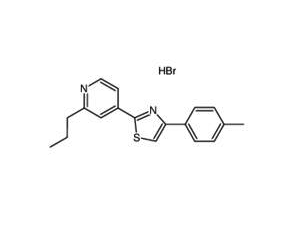
Fatostatin
CAS No. 298197-04-3
Fatostatin( —— )
Catalog No. M18384 CAS No. 298197-04-3
Fatostatin ia an inhibitor of sterol regulatory element binding protein (SREBP). It impairs the activation of SREBP-1 and SREBP-2.
Purity : >98% (HPLC)
 COA
COA
 Datasheet
Datasheet
 HNMR
HNMR
 HPLC
HPLC
 MSDS
MSDS
 Handing Instructions
Handing Instructions
| Size | Price / USD | Stock | Quantity |
| 5MG | 39 | In Stock |


|
| 10MG | 60 | In Stock |


|
| 25MG | 109 | In Stock |


|
| 50MG | 182 | In Stock |


|
| 100MG | 309 | In Stock |


|
| 500MG | 746 | In Stock |


|
| 1G | Get Quote | In Stock |


|
Biological Information
-
Product NameFatostatin
-
NoteResearch use only, not for human use.
-
Brief DescriptionFatostatin ia an inhibitor of sterol regulatory element binding protein (SREBP). It impairs the activation of SREBP-1 and SREBP-2.
-
DescriptionFatostatin ia an inhibitor of sterol regulatory element binding protein (SREBP). It impairs the activation of SREBP-1 and SREBP-2.(In Vitro):Fatostatin hydrobromide (125B11 hydrobromide) (0.1-1 μM; 3 days) inhibits the androgen-independent prostate cancer cell proliferation (IC50=0.1 μM) in an independent of the known IGF1-signaling pathway. Fatostatin hydrobromide inhibits insulin-induced adipogenesis of 3T3-L1 cells.(In Vivo):Fatostatin hydrobromide (125B11 hydrobromide) (30 mg/kg; 150 mL; i.p.; daily for 28 days) reduces adiposity, ameliorates fatty liver by reducing triglyceride (TG) storage, and lowers hyperglycemia in ob/ob mice.
-
In VitroCell Proliferation Assay Cell Line:DU-145 cells Concentration:0.1, 1 μM Incubation Time:3 days Result:Impaired the IGF1-induced growth at an IC50 of 0.1 μM.
-
In VivoAnimal Model:Four-to-five-week-old homozygous male obese (ob/ob) mice (C57BL/6J)Dosage:30 mg/kg; 150 mL Administration:i.p. injection; daily for 28 days Result:Blocked increases in body weight, blood glucose, and hepatic fat accumulation in obese ob/ob mice, even under uncontrolled food intake.
-
Synonyms——
-
PathwayGPCR/G Protein
-
TargetCannabinoid Receptor
-
RecptorSREBPs
-
Research AreaOthers-Field
-
Indication——
Chemical Information
-
CAS Number298197-04-3
-
Formula Weight375.33
-
Molecular FormulaC18H18N2S·HBr
-
Purity>98% (HPLC)
-
SolubilityIn Vitro:?DMSO : 25 mg/mL (66.61 mM)
-
SMILESCc1ccc(cc1)c1csc(c2cc(CCC)ncc2)n1.Br
-
Chemical Name——
Shipping & Storage Information
-
Storage(-20℃)
-
ShippingWith Ice Pack
-
Stability≥ 2 years
Reference
1. Kamisuki S, et al. A small molecule that blocks fat synthesis by inhibiting the activation of SREBP.Chem Biol. 2009, 16(8):882-92.
molnova catalog



related products
-
UR-144
A potent, selective full agonist of the peripheral cannabinoid receptor CB2 with Ki of 1.8 nM.
-
PrNMI
PrNMI is a peripherally restricted cannabinoid 1 receptor (CB1R) agonist.
-
CB1-IN-4
CB1-IN-4 is a potent, selective, peripherally restricted cannabinoid-1 (CB1) receptor antagonist with Ki of 0.3 nM, EC50 of 3.0 nM.



 Cart
Cart
 sales@molnova.com
sales@molnova.com


